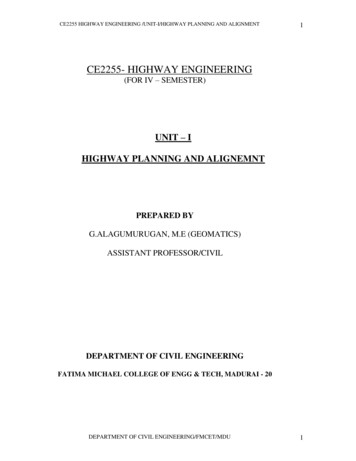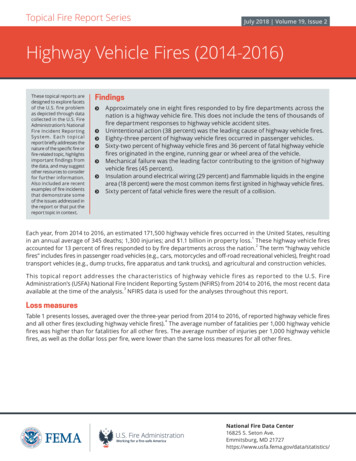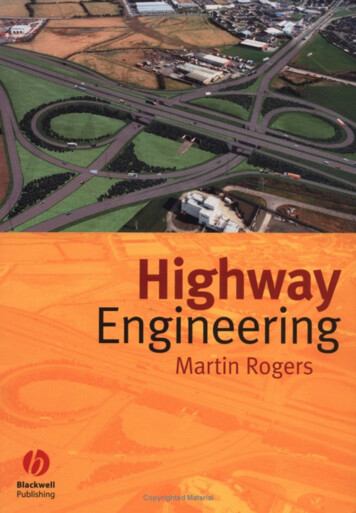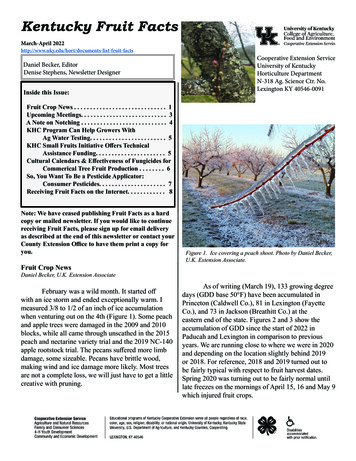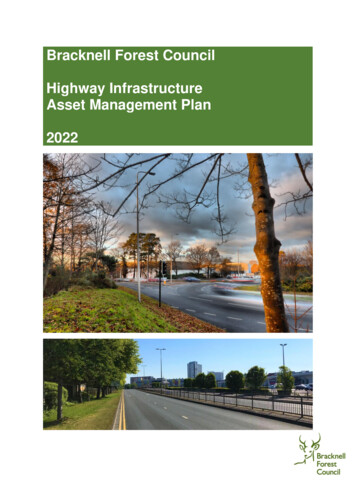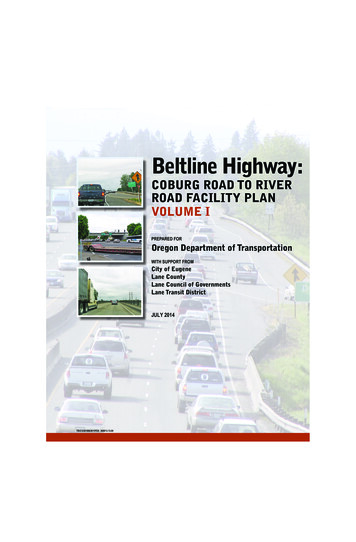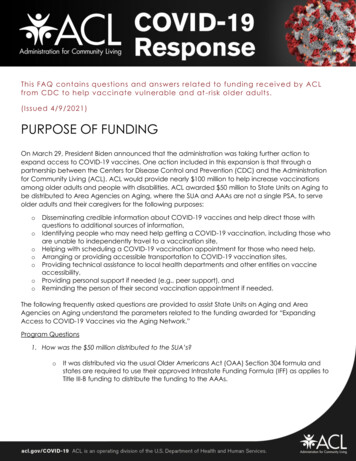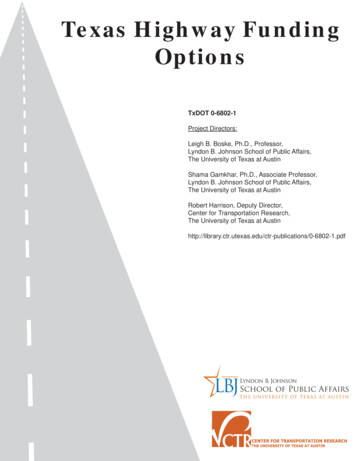
Transcription
Texas Highway FundingOptionsTxDOT 0-6802-1Project Directors:Leigh B. Boske, Ph.D., Professor,Lyndon B. Johnson School of Public Affairs,The University of Texas at AustinShama Gamkhar, Ph.D., Associate Professor,Lyndon B. Johnson School of Public Affairs,The University of Texas at AustinRobert Harrison, Deputy Director,Center for Transportation Research,The University of Texas at ns/0-6802-1.pdf
Technical Report Documentation Page1. Report No.FHWA/TX-13/0-6802-12. GovernmentAccession No.4. Title and SubtitleTexas Highway Funding Options3. Recipient’s Catalog No.5. Report DateJune 2013; Published August 20136. Performing Organization Code7. Author(s)8. Performing Organization Report No.Leigh Boske, Shama Gamkhar, and Robert Harrison; full listing0-6802-1of student authors provided within9. Performing Organization Name and AddressCenter for Transportation ResearchThe University of Texas at Austin1616 Guadalupe St., Suite 4.202Austin, TX 7870110. Work Unit No. (TRAIS)11. Contract or Grant No.0-680212. Sponsoring Agency Name and AddressTexas Department of TransportationResearch and Technology Implementation OfficeP.O. Box 5080Austin, TX 78763-508013. Type of Report and Period CoveredTechnical ReportMay 2012–May 201314. Sponsoring Agency Code15. Supplementary NotesProject performed in cooperation with the Texas Department of Transportation and the Federal HighwayAdministration.16. AbstractThis study was designed to provide strategic information on highway funding options and alternatives inpreparation for the 2013 Texas Legislative Session. The contents evolved during the research team’s twosemester interaction with senior TxDOT staff, led by Mr. Phil Wilson, Executive Director. Three workshopsnarrowed the scope to the four finance issue briefs on the following subjects: energy sector infrastructurefinancing in selected U.S states, weight distance charges, electric vehicle fees, and toll road availabilitypayments. Each brief follows this structure: executive summary, purpose, key points, lessons learned, relevanceto Texas, and appendices.17. Key WordsEnergy exploration, hydraulic fracturing, RUMA18. Distribution StatementNo restrictions. This document is available to thepublic through the National Technical InformationService, Springfield, Virginia 22161; www.ntis.gov.19. Security Classif. (of report) 20. Security Classif. (of this page)UnclassifiedUnclassified21. No. of pages108Form DOT F 1700.7 (8-72) Reproduction of completed page authorized22. Price
Texas Highway FundingOptionsTxDOT 0-6802-1Project Directors:Leigh B. Boske, Ph.D., Professor,Lyndon B. Johnson School of Public Affairs,The University of Texas at AustinShama Gamkhar, Ph.D., Associate Professor,Lyndon B. Johnson School of Public Affairs,The University of Texas at AustinRobert Harrison, Deputy Director,Center for Transportation Research,The University of Texas at Austin
Policy Research Project ParticipantsStudentsAndres D. Diamond-Ortiz, B.A. (Economics), Princeton UniversityAlexandra L. Harwin, B.A. (Sociology), Stanford UniversityDana R. Lazarus, B.S. (Environmental Science and Engineering), Harvard UniversityJohn Anthony Martin, B.A. (Political Science and Spanish), University of OregonSergio Martinez, B.S. (Civil Engineering), Universidad Industrial de Santander,Colombia; M.S. (Urban and Regional Planning), University of Texas at San Antonio*Alissa Neuhausen, B.S. (Civil Engineering), University of California, BerkeleyWill Payne, B.A. (Political Science), University of South CarolinaCourtney Somerville, B.S. (Communication Studies), University of Texas at AustinTrevor C. Udwin, B.A. (International Studies and Spanish), American UniversityWeihui Zhang, B.A. (English), Hunan University, China; M.A. (InternationalJournalism), Communication University of ChinaProject DirectorsLeigh B. Boske, Ph.D., Professor, Lyndon B. Johnson School of Public Affairs,University of Texas at AustinShama Gamkhar, Ph.D., Associate Professor, Lyndon B. Johnson School ofPublic Affairs, University of Texas at AustinRobert Harrison, Deputy Director, Center for Transportation Research, Universityof Texas at Austin*Participated in the Policy Research Project during the 2012 Fall semesterv
vi
Table of ContentsForeword . viiiAcknowledgments . ixIn Memoriam. xEnergy Sector Infrastructure Financing . 1I.II.III.IV.V.VI.VII.Executive Summary .1Background .1Key Policy Issues .3Lessons Learned.9Relevance in Texas .10Bibliography .12Appendices .14Availability Payment Public Private Partnerships . 31I.II.III.IV.V.VI.VII.Executive Summary .31Background .31Key Policy Issues .33Lessons Learned.37Relevance to Texas .37Bibliography .39Appendix .42Electric Vehicle Fees . 43I.II.III.IV.V.VI.VII.Executive Summary .43Background .44Key Policy Issues .44Lessons Learned.51Relevance in Texas .54Bibliography .55Appendices .59Weight Distance Charges: State Experiences. 63I.II.III.IV.V.VI.VII.Executive Summary .63Background .63Key Policy Issues .64Lessons Learned.70Relevance to Texas .72Bibliography .73Appendices .75vii
ForewordThe Lyndon B. Johnson School of Public Affairs, University of Texas at Austin, hasestablished interdisciplinary research on policy problems as the core of its educational program.A major part of this program is the nine-month policy research project (PRP), in the course ofwhich two or more faculty members from different disciplines direct the research of 10 to 20graduate students of diverse backgrounds on a policy issue of concern to a government ornonprofit agency.During the 2012–2013 academic year, the Texas Department of Transportation (TxDOT)funded, through the Center of Transportation Research (CTR), a policy research project on“Texas Highway Funding Options and Alternatives.” The research team was initially assignedthree major tasks to perform in preparation of the 2013 Texas Legislative Session: Identify a menu of feasible practical funding options to support state highwayinfrastructure investments in the movement of people and freight, as well as mechanismsdesigned to ensure the optimum use of existing infrastructure; Assess the comparative merits of viable options in terms of revenue generation potential,equity considerations, administrative costs, technical feasibility of implementation, andother evaluation criteria; and, Suggest alternative mechanisms to educate and inform the public regarding theseriousness of the transportation challenges.The contents of this final report evolved through the research team’s interaction with keytransportation officials throughout the course of the academic year. Overall direction andguidance was provided by Mr. Phil Wilson, Executive Director, TxDOT. Mr. Wilsonparticipated in three separate workshops (October 2 and December 7, 2012 and February 8,2013) to react to interim findings and then to narrow the scope of study. As a consequence ofguidance provided during the December 7 workshop, the scope of study was narrowed toproducing four finance issue briefs on the following subjects: Energy Sector Infrastructure Financing Weight Distance Charges Electric Vehicle Fees Toll Road Availability PaymentsThe following template was also approved for each of the above-mentioned briefs: Executive Summary Purpose Key Points Lessons Learned Relevance to Texas Appendicesviii
AcknowledgmentsThis policy research project would not have been possible without the generouscontributions of assistance of a great number of individuals and organizations, who are properlycited in the four finance issue briefs. As previously mentioned, overall direction and guidancewas provided by Mr. Phil Wilson, TxDOT’s Executive Director. We are also indebted to thefollowing TxDOT officials for participating in weekly class presentations on a variety of topics,sharing information and data, and suggesting useful contacts: John Barton, P.E., Deputy Executive Director/Chief Engineer James M. Bass, Chief Financial Officer Scott Leonard, Chief Strategy and Administration Officer Shannon Crum, Ph.D., Director, Research and Technology Implementation Office Brian D. Ragland, Director, Finance Division Oliver “Jay” Bond, Legislative Liaison, State Legislative Affairs Division Wade O’Dell, P.E., Project Manager, Research and Technology Implementation Office Will Etheredge, Financial Analyst, Finance DivisionFinally, we wish to express our gratitude for the assistance provided by Jim Reed, Transportation Program Director, National Conference of State Legislatures Steven Polunsky, Director, Senate Committee on Business and Commerce, Texas StateLegislature Brady Franks, Budget Analyst/Clerk, House Committee on Appropriations,Subcommittee on Articles VI, VII, and VIII, Texas State Legislature Louise Rosenzweig, Manager, Library Services, Center for Transportation Research, TheUniversity of Texas at Austinix
In MemoriamIn memory of Dr. Shama Gamkhar, LBJ School faculty member from 1996 to 2013. Hercolleagues and students will miss her.x
Energy Sector Infrastructure FinancingI. Executive SummaryEnergy exploration in the United States is driven by hydraulic fracturing, a process whichimposes additional infrastructure needs in those states where new oil and gas is being produced.Hydraulic fracturing requires a substantial variety of materials, most supplied by trucks whichultimately use farm to market and county road systems not designed for their use. These truckvolumes have accelerated the consumption of highway infrastructure and lowered safety levels,creating a financial need not easily funded from traditional highway user fee mechanisms.In Texas, the use of hydraulic fracturing continues to expand in the Eagle Ford Shaleregion and the counties impacted by this process are struggling to find adequate funding to repairlocal roads and maintain safety standards for the traveling public. Texas currently has nostatewide strategy for financing road repairs resulting from the energy sector impact onroadways.Several states along the Marcellus Shale formation have also been heavily impacted byhydraulic fracturing and have concluded that a “user payment” method is an effective strategyfor funding the necessary road repairs resulting from energy companies expanding efforts in thearea. In particular, Road Use Maintenance Agreements (RUMAs) have proven to be a successfulmechanism in Ohio and West Virginia, and could provide a solution for Texas’ infrastructurefinancing needs.The main lessons learned by both West Virginia and Ohio are the cost effectiveness ofupfront road improvements in regions developing shale gas reserves and the importance of earlycoordination with energy companies in order to facilitate the adaptation of RUMAs for theindustry. These lessons can provide insightful experience to TxDOT if considering utilizingsimilar agreements.II. BackgroundHydraulic fracturing or “fracking” is a process conducted by energy companies to extractoil and natural gas from shale rock formations. Hydraulic fracturing requires the transportation oflarge volumes of water to and from the well site, causing many heavy loads to traverse the farmto market and county roads surrounding the site. These roads, many built in the 1950s, were notdesigned to sustain such weight as required for hydraulic fracturing activities. Many of theaffected counties do not have sufficient funds to repair the road damages. Currently, Texas doesnot have a statewide strategy for addressing this issue.1 Other states impacted by the shale boomhave adopted various strategies to address these funding needs, as is shown in Table 1.1Fehling, 2012.1
Table 1. Energy sector infrastructure financing rth ct FeesYesYesYesPennsylvaniaYesYesOhioYesYes*West VirginiaYesYes*Bonding is an optional component of RUMAs in Ohio.As seen in Table 1, both Texas and North Dakota have addressed the issue by obtainingadditional state or Federal appropriations to finance their infrastructure needs. Louisiana hastaken more of a local government initiative, encouraging individual parishes to negotiatefinancing responsibilities with the energy companies through bonding and impact fees.Pennsylvania, Ohio, and West Virginia all use a combination of maintenance agreements andbonding. Maintenance agreements require energy companies to pay for necessary road repairs(or, in some cases, upfront improvements). They often include a bonding requirement. A bond isa dollar amount (similar to a security deposit) that the well operators must commit to ensure thatthey will operate within the parameters of their road use maintenance agreement.Maintenance agreements and bonding are notable in that they place the costs of roadrepairs with energy companies rather than state or local governments. The sections below discussin more detail the use of Excess Use Maintenance Agreements in Pennsylvania and the use ofRUMAs in Ohio and West Virginia. The remainder of this report focuses on the use of RUMAsas a useful and relevant financing mechanism for Texas.Pennsylvania: Excess Use Maintenance Agreements and Impact FeesPennsylvania, one of the first states impacted by hydraulic fracturing, uses Excess UseMaintenance Agreements to require the energy sector to make repairs to roads impacted by theiractivities, and to post a bond for their routes. 3 Although the Excess Use MaintenanceAgreements have helped to facilitate road repairs in Pennsylvania, the energy industry is learningthat making improvements to impacted roadways before the commencement of drilling activitiesmay ultimately be more cost-effective.4 Pennsylvania also charges an impact fee for each drilledwell, which is set based on the Consumer Price Index and natural gas prices. 5 The proceeds fromthe fee are distributed to state and local governments, but are not specifically earmarked forinfrastructure needs.62Hazlett, 2012; Holtsclaw et al., 2013; Jones, 2013; MacAdam, 2012; Tinjum, 2012; Wilson, 2013.Matter et al., 2013.4Matter et al., 2013.5Hazlett, 2012.6Hazlett, 2012.32
Ohio and West Virginia: Road Use Maintenance AgreementsOhio and West Virginia both use Road Use Maintenance Agreements (RUMAs) toaddress the infrastructure impacts stemming from hydraulic fracturing. These agreements aresimilar in principle to Pennsylvania’s Excess Use Maintenance Agreements in that they holdenergy companies financially responsible for the infrastructure impacts of hydraulic fracturing.However, one key difference is that they require energy companies to make improvements toinsufficient roads before drilling activity begins, as well as maintain and repair the roadsthroughout the hydraulic fracturing process. RUMAs are an interesting solution to theinfrastructure problem because they place the burden of road improvements with the energycompanies, rather than with state or local governments. Additionally, in states like Ohio whereroads are maintained by counties or townships, RUMAs can be implemented locally without theneed for a large role for the state Department of Transportation (DOT). For these reasons,RUMAs provide a potential solution for addressing the infrastructure impacts of the shaleindustry in Texas.III. Key Policy IssuesBoth Ohio and West Virginia use RUMAs to address the infrastructure impactsassociated with hydraulic fracturing. The RUMA is a legal agreement between the well operatorand the state or local authority. RUMAs hold energy companies responsible for roadmaintenance and repairs, as well as for upfront improvements if they are necessary. In bothstates, legislation requires that a RUMA must be in place before a well operator can receive adrilling permit. Table 2 presents general information about the use of RUMAs in Ohio and WestVirginia, and the sections that follow discuss in detail the background, development, andimplementation of RUMAs in the two states.3
Table 2. Comparison of RUMAs in Ohio and West Virginia7OhioWest VirginiaAgreementbetween Well operator and local authority Well operator and WVDOTAuthority State, local, and industryrepresentatives created standardizedRUMA Requirement enacted in 2012legislation WVDOT negotiated policy with industry Requirement enacted in 2011 legislationRole of StateDOT Issues permits for state routes 3rd party facilitator during RUMAdevelopment Negotiates RUMAs with well operators Monitors road condition throughoutprocessBondingComponent Optional; not widely used 150,000- 400,000 per mile,depending on type of road Required for every RUMA 1 million for state-wide bond, 250,000for single district If WVDOT calls in bond, all coveredroutes are shut downUse of RUMAs in OhioBackground on Shale ActivityHydraulic fracturing activity in Ohio is centered in the Marcellus and Utica shale plays.The shale industry reached Ohio in 2011, with activity centered in Carroll County and focusedon wet gas extraction.8 There are currently over 500 shale wells in Ohio.9 Chesapeake Energy isa major player in Ohio, with over 100 wells in the state.10Ohio Department of Transportation (ODOT) officials traveled around the state in 2011,letting local governments know that shale drilling was coming. The primary concerns wereenvironmental and infrastructure impacts.11 Energy companies came to Ohio having learned inPennsylvania that upfront improvements could be much more cost-effective than ex-post roadrepairs.State Jurisdiction over RoadsOhio is a home rule state; the state is responsible for state highways, while counties andtownships are responsible for all other roads.12 Approximately 40% of shale drilling sites in Ohioare directly connected to a state highway. Since state highways are designed to handle the truckloads from the shale industry, well operators may simply obtain a permit from ODOT to use stateroutes and are not required to enter into a RUMA. The remaining 60% of truck activity occurs on7Holtsclaw et al., 2013; MacAdam, 2012; MacAdam, 2013.MacAdam, 2012.9Ohio Department of Natural Resources, 2013.10MacAdam, 2012.11Ibid.12Ibid.84
county and township roads, which often are not built to accommodate the heavy truck traffic.13Therefore, in Ohio (as in Texas), it is the roads maintained by local jurisdictions, rather thanthose maintained by the state, that are most in need of improvements due to shale activity. InOhio, RUMAs are established between energy companies and counties or townships, rather thanwith the state DOT. This can make the RUMA process more cumbersome for energy companiesto navigate, since they must negotiate with different local authorities depending on the locationof the drilling site.History/Development of RUMAsPrior to the shale boom, RUMAs were used in Ohio to address road impacts from thecoal and timber industries. When the shale boom reached Ohio, these agreements were adaptedto address problems posed by hydraulic fracturing. At the time, RUMAs were not standardizedbetween counties and townships, and varied in length and requirements. In 2011, the state DOTconvened stakeholders to craft a standardized RUMA to apply to the shale industry. Over thecourse of three meetings, 31 stakeholders—including county commissioners, township trustees,county engineers, energy sector representatives, and state emergency management and naturalresources officials—drafted a standardized RUMA. Due to the nature of road jurisdictions inOhio, the state DOT played a facilitation role in these discussions, since its own routes were notheavily impacted by shale activity.14Once drafted, the standardized agreement was taken to the state legislature, where it wasenacted into law as Senate Bill (SB) 315 on June 11, 2012. The legislation is broad, requiring aRUMA to be negotiated between the energy company and the affected locality before a drillingpermit can be issued, with the standardized RUMA to serve as a starting point for negotiations.15RUMA RequirementsRUMA ProcessOhio legislation requires well operators to have a RUMA in place prior to obtaining thedrilling permit. The RUMA is negotiated between the well operator and the county or townshipin which they will be hauling. In the RUMA, the energy company agrees to improve the road andprovide necessary maintenance and repairs. The costs of road improvement projects can rangefrom 50,000 to 3 million. Chesapeake spends an average of 600,000 per project in Ohio.16As part of the RUMA, the energy company must complete an engineering study of theproposed route and an analysis of the impacts of their predicted truck activity. If the road cannotsupport the expected truck activity, the operator submits a design to the county engineer for thecounty or township affected. Once the county engineer approves the design, both parties sign theRUMA and the well operator can obtain the drilling permit. However, before drilling can begin,the well operator must complete the specified paving project(s), usually by hiring a contractor.The well operator remains responsible for road maintenance and repairs until activity at thedrilling site ceases. The road must be maintained at an equal or greater level than its conditionbefore drilling activity began.1713MacAdam, 2013.MacAdam, 2013. MacAdam, 2012.15Ibid.16MacAdam, 2013.17Ibid.145
One difficulty the state currently faces is that the time it takes to negotiate a RUMA withlocalities adds on average four weeks to the permitting process. This means that companies mustwait an additional four to six weeks before they receive their permit to drill. The state is currentlyworking to streamline the process for negotiating a RUMA between energy companies and localjurisdictions.18BondingBonding is an optional component for RUMAs in Ohio, but is not widely used.Generally, if a company makes upfront improvements, a bond is not required as part of theRUMA. Sometimes smaller energy companies may elect to purchase a bond rather than makeimprovements to the road because of financial constraints. However, due to the depth of theUtica shale, for the most part only larger companies have been drilling there, and thesecompanies have generally elected to make improvements to the roads. For those companies thatdo choose to use bonds, they are assessed at 150,000 to 400,000 per mile, depending on thetype of road.19Other Aspects of RUMAsThere are other unique aspects to the use of RUMAs in Ohio. One prominent feature isthat if an energy company encounters difficulty negotiating an agreement with a localjurisdiction, the company may submit an affidavit substantiating their efforts to reach anagreement and receive a drilling permit from the Ohio Department of Natural Resources (DNR),despite not having reached an agreement with the locality. Negotiations are often more difficultwhen localities are negotiating their first few RUMAs, as there are substantial roadimprovements to be made and the local officials are new to the RUMA process.20 However, evenin the few cases where an operator has obtained a drilling permit without establishing a RUMA,the parties have later been able to reach agreement on road improvements.21Another complication occurs when multiple operators use the same route. In these cases,the first company to begin drilling is usually responsible for the improvements. However, thestate asks the companies to negotiate amongst themselves the responsibility for futuremaintenance. Additionally, where a route goes through multiple counties and townships, aseparate agreement must be negotiated with each locality.22ResultsOhio considers its use of RUMAs to address the infrastructure impacts of hydraulicfracturing to be a success. To date, 95% of road improvements associated with shale drillinghave been paid for by the energy industry through the use of RUMAs.23 In Carroll County alonethere have been 100 RUMAs constituting 40 million of improvements. 24 One factorcontributing to the success in Ohio is the cooperation of the energy industry. The state was ableto get buy-in from industry by including them in the development process and providing animprovement (a standardized RUMA) on current conditions. Additionally, the energy industry18Ibid.MacAdam, 2012.20MacAdam, 2013.21Ibid.22Ibid.23MacAdam, 2012.24MacAdam, 2013.196
had learned from their experiences in Pennsylvania that upfront road improvements are muchmore cost-effective, and therefore were willing to discuss doing so in Ohio.25Use of RUMAs in West VirginiaBackground on Shale ActivityThe Marcellus Shale deposit lies beneath the majority of the state of West Virginia. Thefirst horizontal well in West Virginia was drilled in late 2008. While the West VirginiaDepartment of Transportation (WVDOT) had experience negotiating routes for overweightvehicles with the coal industry, they did not anticipate the infrastructure needs of the energyindustry for the development of hydraulic fracturing26 27. The large size of a drill site requireslonger routes for the energy companies and these routes are typically traveled for three to fourmonths during the duration of hydraulic fracturing. The size of the equipment, number of trucks,and weight of the loads (particularly the amount of water necessary for the hydraulic fracturingprocedure) traversing these routes quickly demonstrated to the WVDOT that changes would benecessary in order for the state to accommodate the needs of both the energy industry and thecitizens living along these routes28.State Jurisdiction over RoadsThe ease with which West Virginia has been able to implement RUMAs is attributable tothe fact that WVDOT has authority over all roads in the state. The energy companies are able towork directly with the DOT to negotiate all necessary agreements29.History/Development of RUMAsWVDOT has experience dealing with overweight loads on farm to market and countyroads connected with the coal industry. When haulers for the coal companies travel ondesignated routes, they are required to buy permits that will fund any damages to the roadscaused by the overweight vehicles30. However, as the hydraulic fracturing
11. Contract or Grant No. 0-6802 12. Sponsoring Agency Name and Address Texas Department of Transportation Research and Technology Implementation Office P.O. Box 5080 Austin, TX 78763-5080 13. Type of Report and Period Covered Technical Report May 2012-May 2013 14. Sponsoring Agency Code 15. Supplementary Notes

